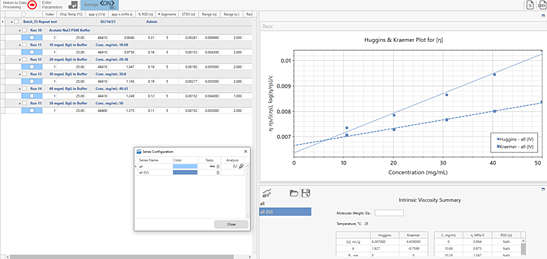Intrinsic viscosity can be quantified as an increase in viscosity as a result of adding an infinitesimal amount of solute to a solvent. This parameter must be calculated. The intrinsic viscosity protocol involves measurement of a concentration series in the dilute regime. The analysis is simplified in the dilute limit since viscosity can be expressed as a series expansion in concentration. The coefficients can then be used to quantify the individual protein contribution and the pair or protein-protein interactions (PPI). The parameters characterizing the individual proteins and their interactions are defined by the Huggins equation, which is a power series expansion of the relative viscosity in terms of concentration applicable in the dilute regime (Macosko, 1994).
 Intrinsic viscosity analysis can be used to examine the molecular structure and interactions of molecules in suspension. The intrinsic viscosity is a useful parameter for proteins, polymers, and other colloidal suspensions. Intrinsic viscosity measures a solute’s contribution to viscosity at infinite dilution and can be used to calculate molecular properties of a sample, such as
Intrinsic viscosity analysis can be used to examine the molecular structure and interactions of molecules in suspension. The intrinsic viscosity is a useful parameter for proteins, polymers, and other colloidal suspensions. Intrinsic viscosity measures a solute’s contribution to viscosity at infinite dilution and can be used to calculate molecular properties of a sample, such as
- Molecular size
- Molecular weight
- Molecular stability (aggregation, denaturation, or conformational changes of protein molecules)
- Polymerization
- Interaction of molecules
- Degradation
- Branching structure
- Protein structure and melting temperatures
The key to accurately measuring intrinsic viscosity is repeatability. RheoSense VROC® powered viscometers offer exceptional repeatability (0.5% of reading), which ensures that you are able to quickly and easily obtain highly accurate (2%), reliable results using small samples.
In our application note, Rheology Tools - Determining Intrinsic Viscosity, we step through a simple procedure to determine the intrinsic viscosity of Bovine gamma globulin in acetate buffer solutions. We begin with the derivation of intrinsic viscosity and defining the parameters needed to calculate it from your viscosity measurements. We then show how to calculate the intrinsic viscosity from dynamic viscosity data using Microsoft Excel and RheoSense’s own data analysis software Clariti™. Clariti™ is the RheoSense proprietary software for data organization and analysis, integrating with both our VROC® initium one plus v and our m-VROC® viscometers. Clariti takes traditional data analysis files, such as Excel/Word documents, and compresses them into an easy to view format, generating an array of comprehensive graphs and providing thorough detailed analysis. With Clariti you are able to determine intrinsic viscosity calculations and injectability predictions.


